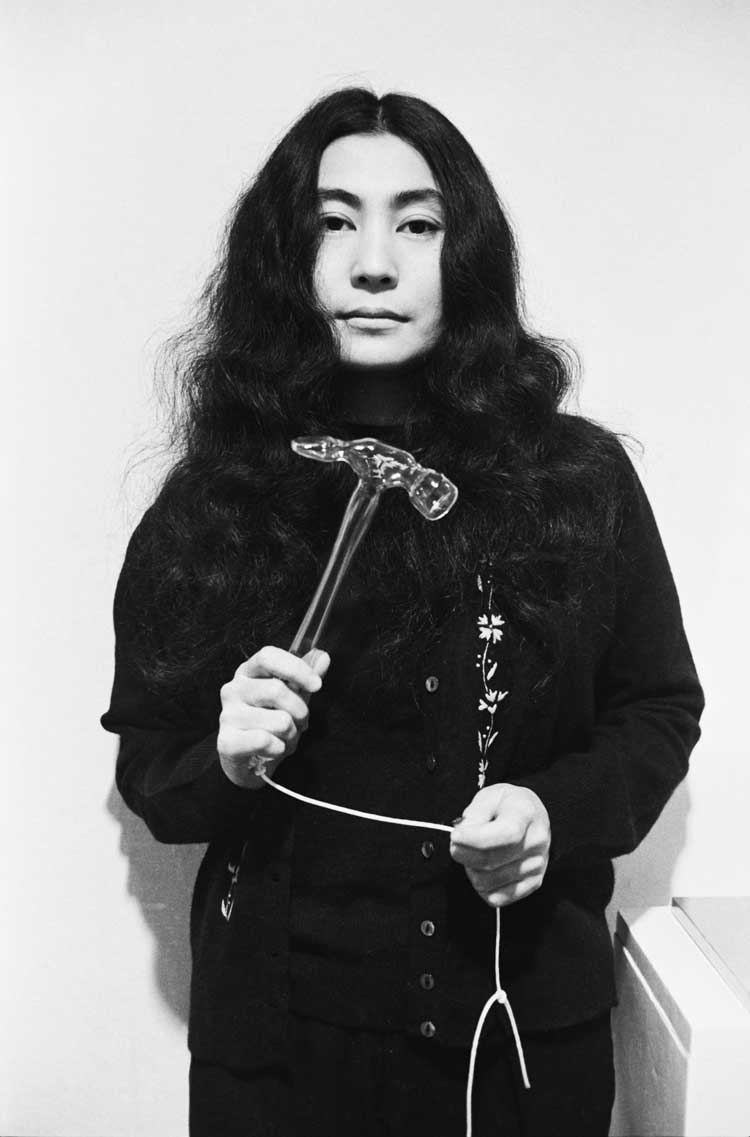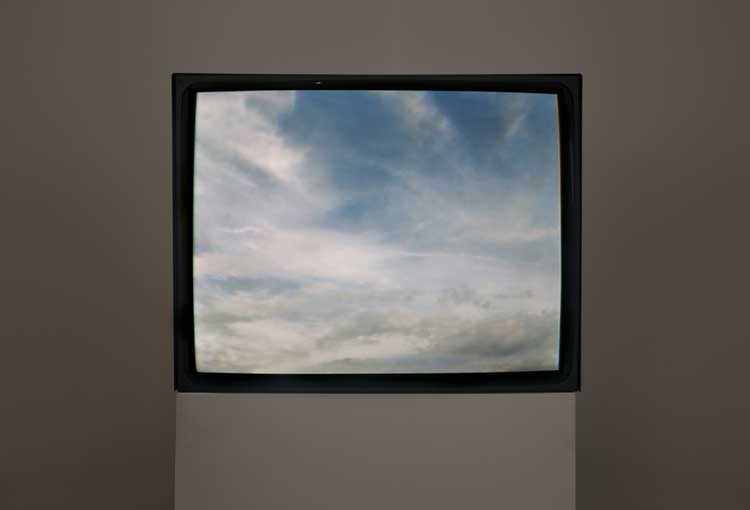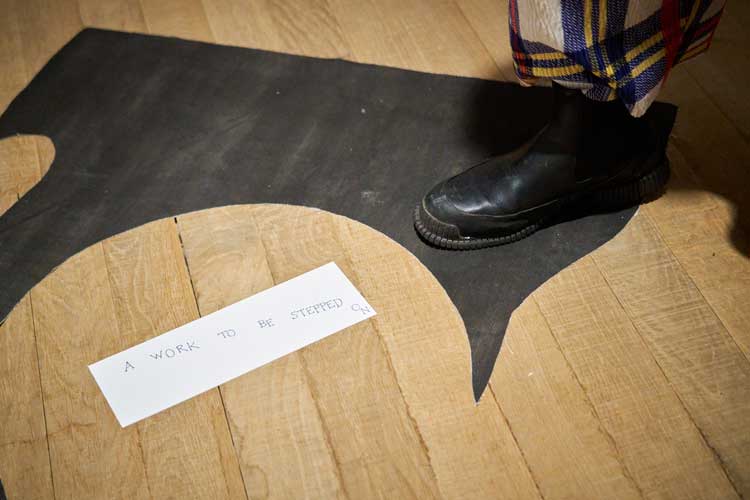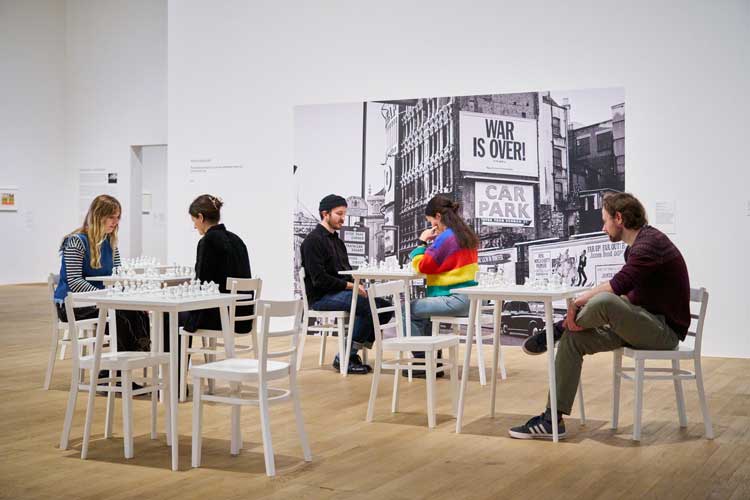-(2).jpg)
Tate Modern, London
15 February – 1 September 2024
by BETH WILLIAMSON
Yoko Ono (b1933) has been one of the most iconic names in global art and activism spanning the seven decades since 1955. Her groundbreaking work in early conceptual and participatory art, film and performance, as well as her work as a musician and notable campaigner for peace is unparalleled in almost every respect. With more than 200 works, including instruction pieces and scores, music, film, installation and photography, this exhibition interrogates the artist’s approach to art, participation and language, an approach that still resonates strongly today. Set to be a blockbuster from the moment of its opening, the exhibition was sold out on the day I visited and packed with visitors clearly stimulated by the work’s variously poetic, funny and philosophical approaches. Well known for her anti-war stance and world peace campaigning, Ono’s convictions feel more prescient than ever in the contemporary climate. Her appetite for experimentation and risk-taking is mind-boggling and only becomes more so with every work encountered. The exhibition certainly plays to her desire to stimulate the imagination, taking its title from her comment: “The only sound that exists to me is the sound of the mind. My works are only to induce music of the mind in people … in the mind-world, things spread out and go beyond time.”

Yoko Ono with Glass Hammer 1967 from HALF-A-WIND SHOW, Lisson Gallery, London, 1967. Photo: © Clay Perry.
The very first work in this exhibition is Lighting Piece (1955). Ono’s instruction is to simply light a match and watch until it goes out. The childhood origins of this piece are interesting in themselves since Ono was extremely sensitive to sound, hiding in the dark and blocking her ears to close off ambient sounds. She repeatedly lit a match and watched it burn out while the sounds in her mind quietened. Although the concept for the work dates to 1955, it wasn’t printed until c1963-64 when it appeared in her book Grapefruit (1964). Every aspect of the development of this concept is explored as the instruction is accompanied by an associated film, Film No 1 (Match) / Fluxfilm No14 (1966), which captures the flame of a match flickering to a stop in slow motion. Further, a series of photographs show Ono performing Lighting Piece in 1962, for an audience at Works of Yoko Ono in the Sogetsu Art Center in Tokyo. She said: “I wanted most things to be performed in the dark, thereby asking the audience to stretch their imaginations.” To explore a single small concept in ways that result in such a variety of work that still engages audiences decades later is a phenomenal achievement.

Yoko Ono, Sky TV 1966/2014. Courtesy the artist. Installation view courtesy of Hirshhorn Museum and Sculpture Garden. Photo: © Cathy Carver.
As a young child fleeing Tokyo during the second world war, Ono found comfort in the constant presence of the sky and it is a recurring theme in her work and a metaphor for freedom and limitlessness. It is something else that she explores in myriad ways, including the instruction piece Painting to See the Skies (1961). The installation SKY TV (1966) is once again realised in this exhibition, showing a live feed of the sky above Tate Modern.
.jpg)
Yoko Ono, Helmets (Pieces of Sky), 2001, installation view, Yoko Ono: Music of the Mind, Tate Modern, London, 2024. Photo: © Tate/Lucy Green.
Helmets (Pieces of Sky), first realised in 2001, invites visitors to take their own puzzle-piece of sky from one of many upturned military helmets suspended from the ceiling. Even though the puzzle pieces are dispersed randomly, they remain designed to come together suggesting the possibility of completeness, hope and peace.

Yoko Ono, Painting to be Stepped On, 1961, installation view, Yoko Ono: Music of the Mind, Tate Modern, London, 2024. Photo: © Tate/Reece Straw.
The invitation for audiences to participate in Ono’s work is present almost from the beginning of her practice. A series of instructional paintings and drawings shown at AG Gallery in New York in 1961 – Ono’s first solo exhibition – invites the audience to complete a painting. Tate Modern audiences are invited to engage with a recreation of Painting to Be Stepped On (1960/61).
.jpg)
Yoko Ono, Bag Piece, 1964, installation view, Yoko Ono: Music of the Mind, Tate Modern, London, 2024. Photo: © Tate/Lucy Green.
Elsewhere in this exhibition is Bag Piece (1964), an opportunity for visitors to climb inside a black cloth bag and become what Ono described as “just a spirit or a soul”. Unfinished paintings or objects require audience members to complete them, by, for example, hammering a nail into board. There are all-white chess sets on all-white boards for visitors who are instructed to “play as long as you can remember where your pieces are”. White Chess Set demonstrates Ono’s anti-war stance and was first realised in 1966.

Yoko Ono, White Chess Set, 1966, installation view, Yoko Ono: Music of the Mind, Tate Modern, London, 2024. Photo: © Tate/Reece Straw.
One of the most popular pieces in this exhibition is Add Colour (Refugee Boat) conceived in 1960. In this iteration, visitors are invited to add colour to the initially all-white room and boat. The artist’s instruction for this collective participatory work is: “Just blue like the ocean.” Visitors are invited to contribute their hopes and beliefs in blue and white and to reflect on the impact that collective action might have. It is an ode to the possibility of peace, something that has been a constant in everything Ono does.
Some of her best-known work campaigning for peace was made in collaboration with her late husband, John Lennon, with three pieces made in 1969. The couple sent Acorns for Peace to world leaders. In a billboard campaign, “War is Over! (if you want it)”, a message of peace is conveyed through the language of advertising. Bed Peace saw the couple’s notorious “bed-in” events in Amsterdam and Montreal, where they spoke to the media to promote world peace in the midst of the Vietnam war. Twenty-five years later, in 1983, Ono placed an advertisement in the form of an article in the New York Times. It was titled Surrender to Peace. Still, Ono maintains her desire to heal the self and the world, and share her message of world peace. It is a laudable ambition by any measure and this exhibition makes you wonder if it might just be possible.
A humongous survey of contemporary painting in Belgium shows a medium embracing the burden of its hi...
A retrospective of the first 20 years of the Max Mara Art Prize for Women finds an inexhaustible wel...
This new work is very much about indeterminate selfhood as Nora Turato immerses the visitor in a swi...
Burmese artist Htein Lin has been jailed many times and this show includes some of the remarkable pa...
This retrospective brings the acclaimed and trailblazing, but nearly forgotten French modernist arti...
Mainie Jellett and Evie Hone: The Art of Friendship
A kaleidoscope of colour through which the history of modernism is refracted, this exhibition brings...
In this major retrospective, the viewer is like an avatar navigating the humans – real and CGI –...
Sharjah March Meeting 2025: To Carry Songs
Sharjah Art Foundation’s annual symposium this year explored how culture is preserved and shared w...
Christopher Le Brun & Charlotte Verity – interview: ‘There is such a t...
To coincide with a rare joint exhibition now on view at The Gallery at Windsor in Florida, Christoph...
Valentina Karga highlights the ecological horrors ravaging our world, but her aim is not to shock or...
Peter Mitchell: Nothing Lasts Forever
Peter Mitchell’s photographs of urban decay and the demolition of buildings in Leeds over the past...
Lee’s headless heroines and canines are the fifth of the Met’s Genesis Facade Commissions. But w...
Lina Lapelytė – interview: ‘Between this group of performers, what we...
Perhaps best known for her eco-opera Sun & Sea (Marina), Lina Lapelytė discusses her approach to im...
Spanning four centuries and diverse cultures, this show of more than 7o works, including paintings, ...
With highlights from the Courtauld’s collection of German and Austrian modernist works on paper an...
Louise Bourgeois, Sheida Soleimani and Gillian Wearing are among the 30 female artists contributing ...
In this mind-blowing and dazzling exhibition, Rafał Zajko takes us into a mysterious realm of art a...
Mahtab Hussain: What Did You Want to See?
With portraits of mosques and people at prayer, British Asian photographer Mahtab Hussain documents ...
The Cosmos of “Der Blaue Reiter” – From Kandinsky to Campendonk
This show retraces the roots of the expressionist artists who made up the Blue Rider group, looking ...
Celia Paul: Colony of Ghosts* and Celia Paul: Diaries**
Two concurrent solo exhibitions paint a much broader portrait of the artist Celia Paul, debunking th...
Edvard Munch’s portraits have flown under the radar, but getting to know his sitters reveals a lot...
In her films, sculptures, tapestries and prints Yto Barrada plays with the materiality of colour...
Delaine Le Bas – interview: ‘People still have expectations about what...
From the heart of her installation at the White House in east London, Romany artist Delaine Le Bas t...
Olivia Bax – interview: ‘With art, there are so many unwritten rules a...
Sculptor Olivia Bax talks about curating These Mad Hybrids: John Hoyland and Contemporary Sculpture,...
Astonishing Things: The Drawings of Victor Hugo
The Royal Academy of Art’s new exhibition reveals the mighty French novelist as a fascinating, eve...
Symbiosis: Art in the Age of AI
The exhibition presents a gamut of international artists who work with artificial intelligence in va...
Siena: The Rise of Painting, 1300-1350
The National Gallery’s meticulously researched exhibition of medieval Sienese masterpieces is an a...
Somaya Critchlow’s six sombrely sexy paintings respond to European painting from the 17th and 18th...
Elizabeth Fritsch: Otherworldly Vessels
With many objects drawn from Elizabeth Fritsch’s private collection, this first retrospective of t...
Portia Zvavahera – interview: ‘It’s like I’m speaking with the sou...
In her only in-person interview for her latest UK show, now at Fruitmarket, Edinburgh, the artist di...